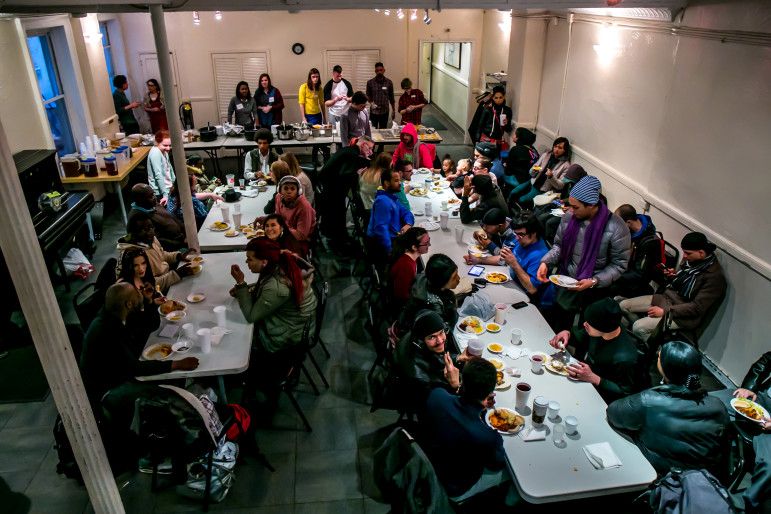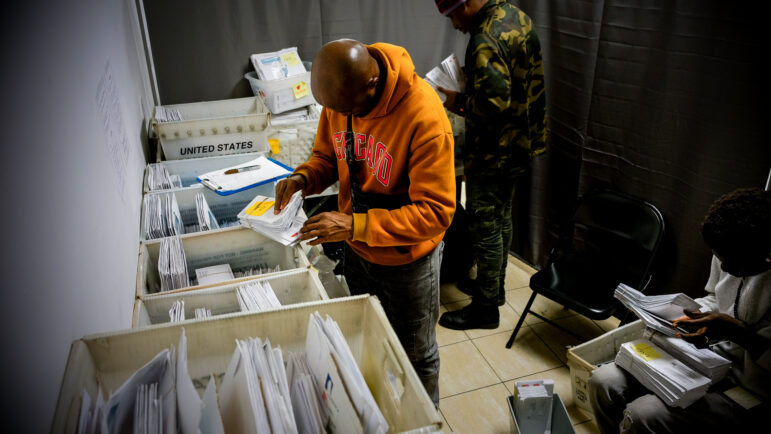“The dated, time-consuming bureaucratic system of meetings with social workers that lead to referrals, appointments and multiple screenings by various organizations must change. Homeless youth deserve timely and accurate information that gives them the best chance of locating the most suitable shelter.”

Adi Talwar
Clients at an LGBTQ+ homeless youth shelter in lower Manhattan, pictured here in 2015.Crystal,* a then-17 year-old chronically homeless pregnant teen who was a victim of domestic violence, was unwilling to meet with the social worker who wanted to help her gain access to a homeless shelter. Crystal seemed likely to meet the criteria of this shelter, and she had heard glowing reviews about it from other young women served by Project Rousseau, a community-based nonprofit serving some of the highest-need youth in New York City.
Despite these compelling factors, however, Crystal was on the verge of giving up: “I’ve done five of these. They always say they’ll take me, but then they don’t. What will be any different this time?”
Crystal, of course, was completely justified in how she felt. And she is not alone. In 2020, NYC identified almost 7,000 unaccompanied or parenting young people under age 25 without stable housing, a number that we believe is significantly underestimated. For these youth, the process of identifying a shelter bed is difficult; many like Crystal “spend their nights ‘doubled up’ with friends or other associates — crashing on a couch in an apartment where their name does not appear on the lease or exchanging sex for a place to sleep,” City Limits previously reported.
Crystal had little reason to be optimistic that one more meeting would change anything. She had already visited multiple homeless shelters and tried multiple intake processes. In each instance she was notified that she was ineligible for the shelter, or that she lacked a piece of necessary documentation. Crystal’s fatigue and skepticism, shared by so many of the over 30,000 homeless youth in New York City are the result of seemingly endless appointments seeking out housing and other services. Many youth like Crystal simply get exhausted and disengage.
Crystal has seen her friends struggle with shelter placements for years. Mustafa* had been down this same road before, just to learn that he could not move into his shelter of choice because he did not have his birth certificate. Allegra* was unable to get required documentation from her school on an urgent turnaround, and Juan* worked with his social worker for over four months, just to be referred to a shelter that required a Social Security card, which he did not have.
Of course, Crystal and her friends have one significant additional tool at their disposal: they have each other. The word-of-mouth expertise that develops within student bodies at Project Rousseau is often transferred to Project Rousseau staff, who use the information to assist them and others. However, while some youth like Crystal are connected to a peer support system, others do not have access to this real-world knowledge.
Fortunately, Crystal persisted, and found just what she needed: Maya’s Place, The Children’s Village shelter for young women. Maya’s Place provides shelter to women and girls between the ages of 16 and 20, including—very fortunately for Crystal—services designed for those who are pregnant and parenting. Project Rousseau has turned to Maya’s Place on numerous occasions. Residents can stay with Maya’s Place for 30 days, though some receive extensions when necessary. Most importantly for Crystal and those like her, The Children’s Village do all they can to make the intake procedures as fast and easy as possible.
The reality is that New York is a city that cares, and we have many shelters doing extraordinary work. The frustrating experiences being reported by many youth like Crystal should not be the norm; the dated, time-consuming bureaucratic system of meetings with social workers that lead to referrals, appointments and multiple screenings by various organizations must change. Homeless youth deserve timely and accurate information that gives them the best chance of locating the most suitable shelter.
One part of the solution is a universal database of youth shelters in New York City. Project Rousseau, with generous support from Goldman Sachs and Globant, has developed an app that will empower young people—and their friends, families, and service providers—to identify shelters that would be most likely to accept them.
The app allows youth to search for shelter availability that best meets their needs and, most importantly, it will clearly list the required admissions criteria, such as the documents needed, gender identity, LGBTQ+ status, or if a shelter permits a young parent to bring their child with them. No more traveling to a screening just to be rejected. This app aims to increase the young person’s sense of agency, and decrease the fatigue and skepticism created by the current process. The Children’s Village and several other shelter providers are eager to participate by populating the app with relevant data.
Rapidly, effectively sheltering young people has many benefits: shelter increases safety, decreases the despondency youth experience and allows experienced social workers to help them achieve stability. Additionally, and perhaps just as importantly, it gives young people like Crystal the confidence that help is real and not a distant promise made by a difficult-to-navigate bureaucracy, and that the help they will be offered next time might be real, too.
At a time when homelessness in New York City is a daily media story, this app is just one example of how corporations can help improve expensive dated systems that must be rebooted to serve those in need more efficiently and effectively.
*Names and some identifying details have been changed to protect anonymity.
Andrew Heinrich is the founder and president of Project Rousseau. Jeremy Kohombaum is the President and CEO of The Children’s Village.









One thought on “Opinion: Fixing the Bureaucratic Hurdles to Shelter Placement for Homeless Youth”
Individuals entering and leaving prisons and jails make up more than 10% of those who are homeless in the months before and after their incarceration (Council of State Governments, 2016). Living in a high-crime area, being homeless, or having unstable housing all increase a person’s risk of reoffending.